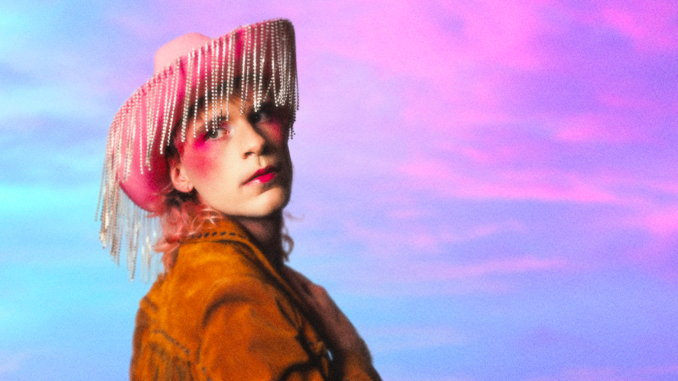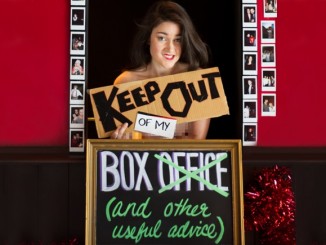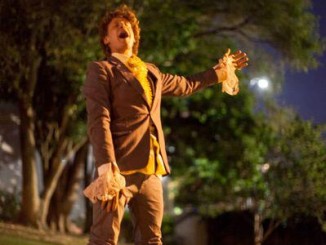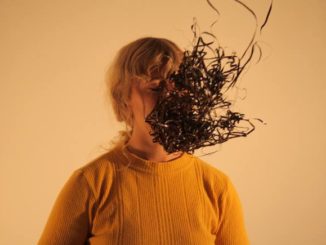
[The Ballad of Billy Bob and Bobby Bill]
Pale pink and white fabric clouds hang in fluffy banks over the Basement Studio stage. On a single mattress are two, improbably still, denim-shorts-clad, cowboys. They lie on top of each other, stacked like flapjacks, with only the flashing of the silver studs on one of their belts giving the impression of movement. A large white sheet is strung between the billowing clouds and the mattress below, bisecting the Studio stage.
In the long moments before the audience fills the seats, and the lighting state changes from the preshow setting, we take in this image of the cowboy at rest. He is not alone on the plains but resting in comfortable companionship. This opening image of repose, of quiet intimacy, is one of the most striking of the show.
Cowboy Dreaming is the latest offering from Lunar Collaborative, presented under the direction of Grace Augustine with devising aid from Bridie Thomson and Kermath Davies. Billed as a development season, the work features Georgie Llewellyn and Emily Hurley in a variety of acts including lip syncs, strip teases, and comedic vignettes referencing the crooners of the past or more recent popular culture memes (for example the satirical TV show Reno 911).
The show blends live performance with a wealth of film footage projected onto the large dividing sheet. When the projector starts up the clouds take on the faded glamour of the cinema curtains now only seen in venues like the Academy Cinema. It is a stage within a stage, performance within a performance, a series of dreams within the Lunar Collaborative dream.
I was curious to find what this dream would offer by way of commentary on, or subversion of, the familiar Western tropes, the queer history of the Old West, and a recent resurgence of the cowboy figure in both queer and wider popular culture. Equally I wondered if there would be reference to the illusory nature of the cowboy narratives which often leave out the colonialism at the heart of Western Expansion in America. The show made repeated use of film footage from the 50s and 60s (think The Good, The Bad, and The Ugly, a full trailer for Johnny Guitar, all smashed together with sweaty late-stage Elvis clips and footage of pounding, surging waves). Later in the work images of gender bending appeared – clips of David Bowie at peak androgyny are played, and Hurley presents a sputtering performance of ‘Life on Mars’. This amalgam of references certainly brought many of these familiar Western tropes to the fore, but if there was a deeper logic behind the selections made, in relation to the staged action, it evaded me.
The Elvis clips offered Llewellyn and Hurley opportunities to engage in some shakin’ and a groanin’ which then lead to ejaculations of various kinds, but pushing this already performative and sexually provocative movement to the extreme did not appear to reveal some new meaning in the movement.
Another clear moment of connection between the film footage and the stage action was equally opaque in intention. One scene, in a mirroring of the action of an earlier clip, saw Hurley undressed and then slowly dressed in a sequined evening gown. I thought this might become a comment upon the feminine body and how it is served up to viewers in either film or theatre forms, but this too seems to be a reproduction of the action rather than an opportunity to divulge some further meaning.
I felt as though I was being tumbled in the waves crashing together on the screen, a feeling further compounded by the Bowie clips which drastically depart from the established (and largely explicitly Western) references and symbols. However, in the nature of a dream, perhaps this is the point.
If you let go of wanting a critical analysis of the figure of the ‘Cowboy’ the show offers many delights, particularly the magnetism of the two central performers. Llewellyn is tremendously gifted (as demonstrated in their extreme gentleness and pathos in the 2022 season of Chrome Dome and Schizo, and their production of side-splitting comedy in The Wedding). Over the course of Cowboy Dreaming, Llewellyn contorts themselves into rictuses of joy and pain in equal measure. It is immensely satisfying to watch an actor so present, so consumed by the moment of performance, that every fibre of the body is engaged. Hurley is equally compelling in various roles including that of a forlorn cowboy lover, an impassive young actor beset by a crazed casting agent, and as a human tumbleweed.
There are many moments which generated great laughter from the audience, and also moments which produced an atmosphere of awe and contemplation, particularly those accompanied by the greatest Western music of all time (Ennio Morricone’s score for Sergio Leone). I found original footage of Hurley garbed in a poncho, Stetson, and cowboy boots striding across (what looked to be) a West Coast beach, oddly captivating. As the scene shifted to the Auckland CBD the curious glances of local punters felt as isolating as the desert-like expanse. Hurley’s cowboy was made an even more lonesome figure for travelling through populated places, a relic of the past adrift in our modern world. This was the most lucid the dream became, and the use of this original film footage could be made even more central to the work.
The opportunity to sleep, to dream, to lie in the arms of your moustachioed lover is –if only for 90 minutes –a sweet respite from the loneliness of the modern world.
Cowboy Dreaming plays the Basement Theatre 27th February to the 2nd of March 2024




Leave a Reply